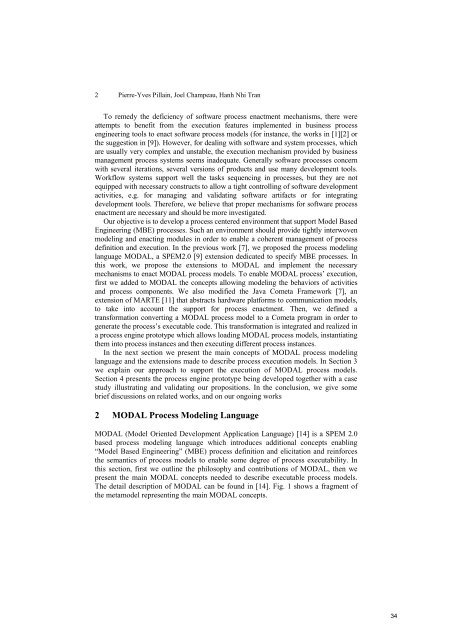A Framework for Integrating ESL Tools - IRIT
A Framework for Integrating ESL Tools - IRIT
A Framework for Integrating ESL Tools - IRIT
You also want an ePaper? Increase the reach of your titles
YUMPU automatically turns print PDFs into web optimized ePapers that Google loves.
2 Pierre-Yves Pillain, Joel Champeau, Hanh Nhi Tran<br />
To remedy the deficiency of software process enactment mechanisms, there were<br />
attempts to benefit from the execution features implemented in business process<br />
engineering tools to enact software process models (<strong>for</strong> instance, the works in [1][2] or<br />
the suggestion in [9]). However, <strong>for</strong> dealing with software and system processes, which<br />
are usually very complex and unstable, the execution mechanism provided by business<br />
management process systems seems inadequate. Generally software processes concern<br />
with several iterations, several versions of products and use many development tools.<br />
Workflow systems support well the tasks sequencing in processes, but they are not<br />
equipped with necessary constructs to allow a tight controlling of software development<br />
activities, e.g. <strong>for</strong> managing and validating software artifacts or <strong>for</strong> integrating<br />
development tools. There<strong>for</strong>e, we believe that proper mechanisms <strong>for</strong> software process<br />
enactment are necessary and should be more investigated.<br />
Our objective is to develop a process centered environment that support Model Based<br />
Engineering (MBE) processes. Such an environment should provide tightly interwoven<br />
modeling and enacting modules in order to enable a coherent management of process<br />
definition and execution. In the previous work [7], we proposed the process modeling<br />
language MODAL, a SPEM2.0 [9] extension dedicated to specify MBE processes. In<br />
this work, we propose the extensions to MODAL and implement the necessary<br />
mechanisms to enact MODAL process models. To enable MODAL process’ execution,<br />
first we added to MODAL the concepts allowing modeling the behaviors of activities<br />
and process components. We also modified the Java Cometa <strong>Framework</strong> [7], an<br />
extension of MARTE [11] that abstracts hardware plat<strong>for</strong>ms to communication models,<br />
to take into account the support <strong>for</strong> process enactment. Then, we defined a<br />
trans<strong>for</strong>mation converting a MODAL process model to a Cometa program in order to<br />
generate the process’s executable code. This trans<strong>for</strong>mation is integrated and realized in<br />
a process engine prototype which allows loading MODAL process models, instantiating<br />
them into process instances and then executing different process instances.<br />
In the next section we present the main concepts of MODAL process modeling<br />
language and the extensions made to describe process execution models. In Section 3<br />
we explain our approach to support the execution of MODAL process models.<br />
Section 4 presents the process engine prototype being developed together with a case<br />
study illustrating and validating our propositions. In the conclusion, we give some<br />
brief discussions on related works, and on our ongoing works<br />
2 MODAL Process Modeling Language<br />
MODAL (Model Oriented Development Application Language) [14] is a SPEM 2.0<br />
based process modeling language which introduces additional concepts enabling<br />
“Model Based Engineering” (MBE) process definition and elicitation and rein<strong>for</strong>ces<br />
the semantics of process models to enable some degree of process executability. In<br />
this section, first we outline the philosophy and contributions of MODAL, then we<br />
present the main MODAL concepts needed to describe executable process models.<br />
The detail description of MODAL can be found in [14]. Fig. 1 shows a fragment of<br />
the metamodel representing the main MODAL concepts.<br />
34

















